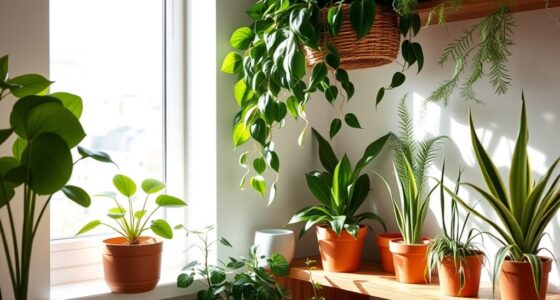To care for your spider plant and propagate offshoots, water thoroughly once a week, keeping the soil moist but not waterlogged, especially during warmer months. Regularly inspect for pests and wipe leaves as needed to prevent infestations. To propagate, wait for offshoots with root systems to develop and then cut and plant them in moist soil. Healthy plants produce more offshoots; maintaining proper watering and pest control helps guarantee vibrant growth—if you want to learn more about each step, keep exploring.
Key Takeaways
- Water weekly, ensuring soil stays moist but not waterlogged, to promote healthy growth and prevent pests.
- Regularly inspect leaves and soil for pests like spider mites and mealybugs, and treat promptly.
- Propagate offshoots by gently removing plantlets with roots and planting them in well-draining soil.
- Maintain bright, indirect light and avoid overwatering to keep the plant healthy and encourage new offshoots.
- Quarantine new plantlets and monitor for pests before integrating them into the main plant.

A spider plant is a popular houseplant known for its easy care and air-purifying qualities. When it comes to keeping your spider plant healthy, establishing a proper watering schedule is essential. You want to water thoroughly, but not so often that the roots sit in water. Typically, watering once a week works well, but always check the top inch of soil first. If it feels dry, it’s time to water; if it’s still moist, wait a few more days. During warmer months or if your home has dry air, you might need to water a bit more frequently. Conversely, in cooler months, reduce watering to prevent overwatering and root rot. Consistency is key—sticking to a regular schedule helps your plant adapt and thrive. Proper watering not only supports healthy growth but also plays a role in pest prevention. Overly moist soil can attract pests like fungus gnats, so keeping the watering schedule balanced helps keep your plant pest-free.
Pest prevention is another critical aspect of spider plant care. While these plants are generally resilient, they can occasionally attract pests such as spider mites, mealybugs, or scale insects. To prevent infestations, regularly inspect your plant’s leaves and soil, especially the undersides of leaves where pests tend to hide. Maintaining good airflow and avoiding excess humidity can deter many pests. Additionally, keeping your plant healthy through proper watering and fertilizing makes it less appealing to pests. If you notice tiny webs, discolored spots, or sticky residue, act quickly. You can gently wipe the affected leaves with a damp cloth or use insecticidal soap to eliminate pests before they multiply. Quarantining new plants before introducing them to your collection can also help prevent pests from spreading. A proactive approach to pest prevention saves you time and effort later on and keeps your spider plant looking vibrant.
Frequently Asked Questions
Can Spider Plants Survive in Low-Light Environments?
Yes, your spider plant can survive in low-light environments thanks to its high low light tolerance. While it thrives in bright, indirect sunlight, it’s adaptable and can manage in dimmer spots. Just keep in mind that in low light, growth may slow, and variegation might fade. To guarantee plant survival, avoid overwatering and provide occasional indirect light to keep it healthy and vibrant.
How Often Should I Repot My Spider Plant?
You should repot your spider plant every 1-2 years to support its growth stages. Even if it seems healthy, roots can become crowded, limiting growth. Imagine the roots spilling over the pot’s edge—it’s time to upgrade. Regular repotting encourages vigorous growth and prevents root-bound issues, ensuring your plant stays vibrant. Keep an eye on its size, and don’t wait too long to give it fresh soil and space to thrive.
What Are Common Pests That Attack Spider Plants?
You might notice pests like spider mites, aphids, or mealybugs attacking your spider plant. To identify these pests, check the leaves and stems closely for tiny bugs or webbing. Use organic pest control methods like neem oil or insecticidal soap to treat infestations safely. Regular pest identification helps you catch problems early and keeps your plant healthy without harsh chemicals.
How Do I Prevent Browning Tips on Spider Plant Leaves?
An ounce of prevention is worth a pound of cure. To avoid leaf tip browning, you should review your watering practices—avoid overwatering or letting the plant sit in water, and guarantee proper humidity. Also, trim brown tips carefully to encourage healthy growth. Regularly check for signs of stress and maintain consistent moisture levels. This way, you keep your spider plant happy and vibrant, with lush, green leaves.
Are There Specific Fertilizers Best for Spider Plants?
You should choose a balanced, water-soluble fertilizer like a 10-10-10 or 20-20-20 formula for your spider plant. These fertilizer types provide essential nutrients that support healthy growth and plant nutrition. Apply the fertilizer monthly during the growing season, and dilute it to half-strength to prevent overfeeding. This approach guarantees your plant gets the right nutrients for vibrant leaves and overall health.
Conclusion
By nurturing your spider plant, you’re cultivating a symbol of resilience and growth. As the offshoots reach out like tiny hands, they remind you that patience and care foster new beginnings. With each leaf and offshoot, your plant becomes a living affirmation to perseverance, encouraging you to nurture your own dreams. Keep tending to it, and watch as your green companion continues to flourish, a beautiful symbol of life’s endless cycles of renewal.









